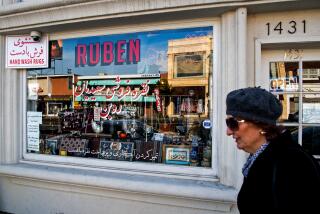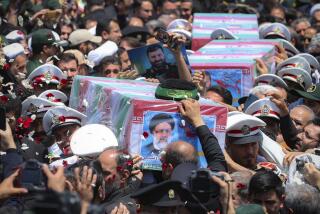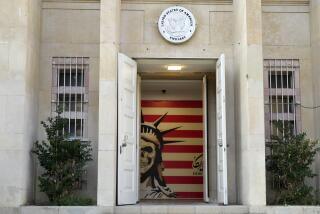Tehran Today: Metropolis of Anomalies
- Share via
TEHRAN — Outside the international airport, along Eisenhower Avenue (since renamed but still called Eisenhower by the locals), bold wall murals depict a jowly Ronald Reagan, a goofy Margaret Thatcher and a horned Saddam Hussein, leader of the Iraqi enemy.
President Bush has yet to make this pantheon of Iran’s satans, which may reflect a shortage of paint or stand as testimony to an easing of the anti-Western line in Tehran.
Today, the Iranian capital, a flat, unremarkable sprawl of 10 million or more on a high plateau beneath the striking Alborz Mountains, is a metropolis of anomalies.
Cultural contamination from abroad was snuffed out a decade ago by the zealous followers of the late Ayatollah Ruhollah Khomeini and his Islamic revolution. Women submitted to the black folds of the chador , a head-to-toe garment revealing nothing but the face and not much of that. Young men affected trimmed, three-day-old beards.
The red-and-white sign of a downtown fried chicken outlet suggests a definite Kentucky heritage, but reads, in English, “Our Fried Chicken” and bears a face far younger than the Colonel’s.
For both foreigners and Tehranis, the chador has been a measurement of cultural restraint in the capital. This fall, fashion is tending toward exposure. Many women still wear the chador , particularly in the working-class neighborhoods of South Tehran. But it is rarely seen in the well-to-do northern reaches of the city.
North Tehrani women long ago opted for a two-piece outfit: a black, ankle-length cloak and a hejab , a scarf that covers the hair. On a recent visit, the scarfs in the northern neighborhoods were often colored paisley prints that would be appreciated on the streets of Paris.
More daring yet were the schoolgirls, who have adopted pompadours that lift the hejab and shamelessly reveal forbidden locks. And their cloaks ride high, showing blue-jeaned legs and white socks and sneakers.
The Islamic komitehs , enforcers of the revolutionary dress code, are no longer so active as in the early days of the revolution, a Tehran-based diplomat said. “They don’t worry so much about the chador ,” he remarked. “It’s the Westerners who are fixed on that.”
But off Los Angeles Avenue (also renamed since the 1979 Islamic revolution), in the lobby of the old Inter-Continental Hotel (also renamed), an assistant manager approached a Western journalist with flame-red hair and quietly instructed her to adjust her head scarf. There had been complaints.
Behind this tableau, on the lobby wall, was a sign declaring in large letters: “Down With the U.S.A.”
Tehran is full of ideological contradictions. The former U.S. Embassy, where 52 Americans were once held hostage for 444 days, is occupied by the Pasdaran--the Revolutionary Guards--who hold military classes there. On either side of the iron gates, the walls are plastered with anti-Western graffiti. “Make America Face Severe Defeat,” says one. “The Superpowers’ Right of Veto Is Worse Than the Law of the Jungle,” informs another.
On the street outside rattles by the aged fleet of Tehran motor vehicles, an estimated 3 million cars, according to one driver, and few without scars from the horrendous Tehran traffic. A spotless exception on a recent day was a white Cadillac whose passengers, two white-turbaned mullahs, could be seen through the rear window.
Perhaps most surprising for a visitor were the ubiquitous portraits of Khomeini. The brooding visage usually seen in the West is not unusual here, but more popular is a color photo of an old man with a slight and pleasing smile.
More to Read
Sign up for Essential California
The most important California stories and recommendations in your inbox every morning.
You may occasionally receive promotional content from the Los Angeles Times.










